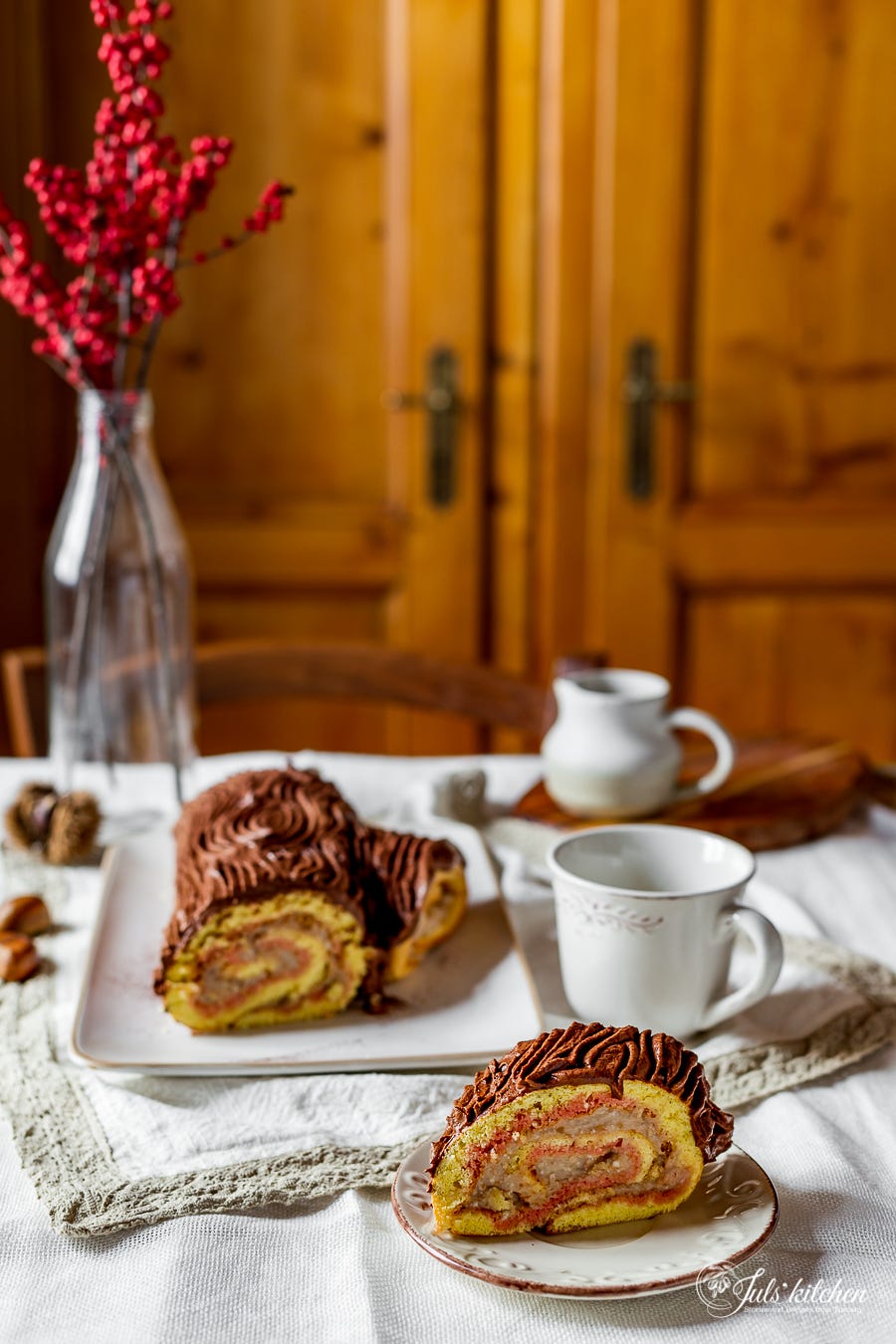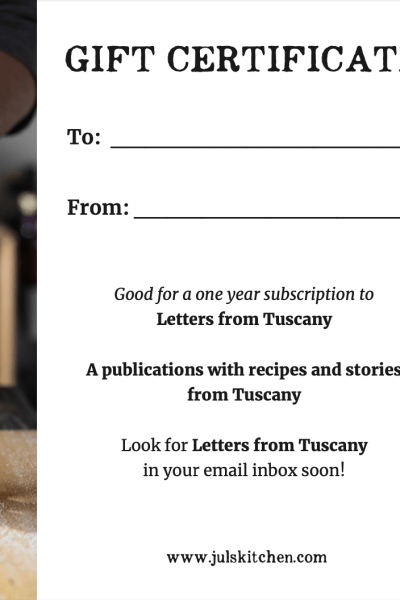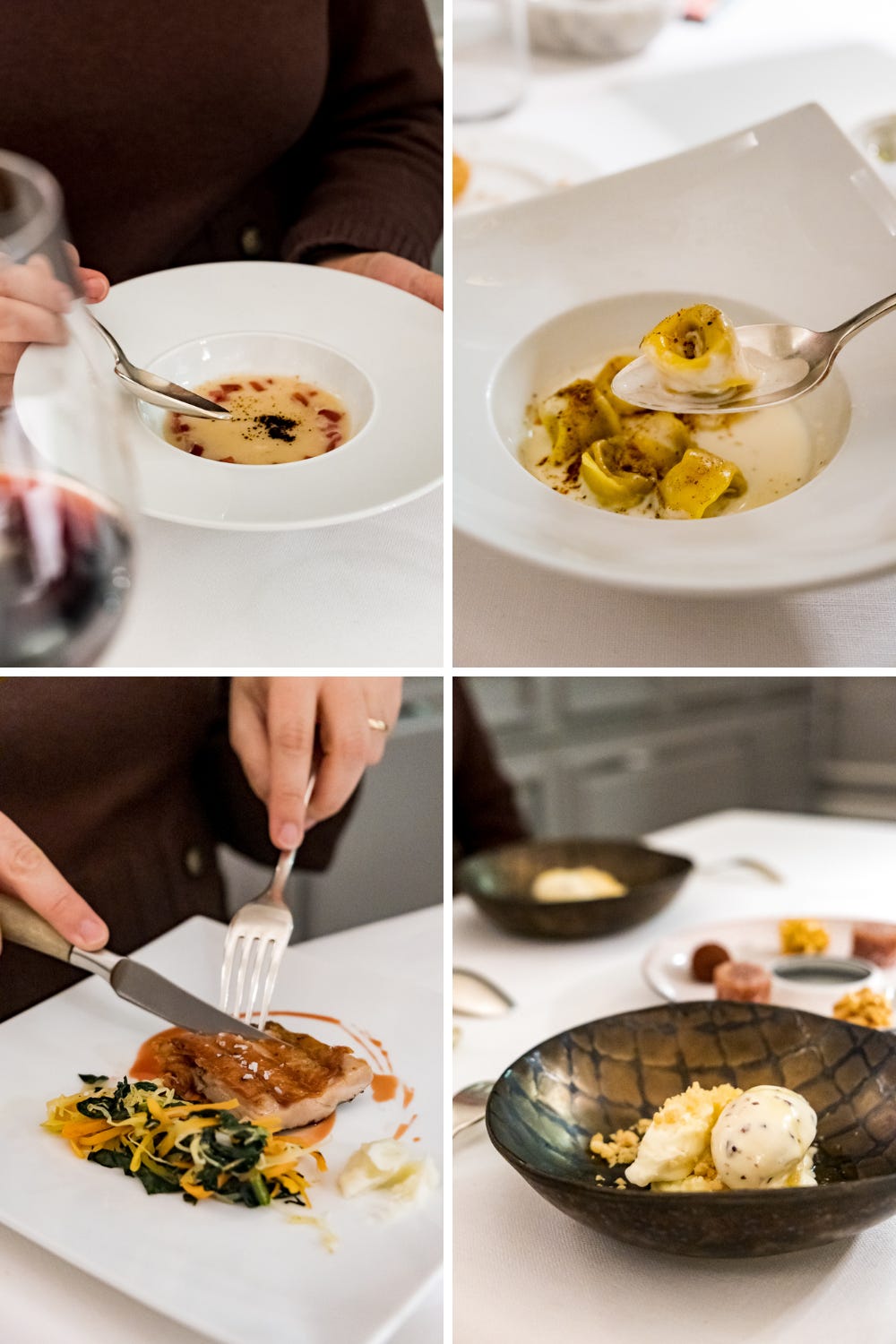How to turn your Swiss roll into a festive Yule Log
Celebrating Christmas and the deep connection to Nature and to ancient rituals
We’ve been making Swiss rolls since I was a child, it was our go-to dessert to bring to a dinner party with friends because it would please both adults and children. It was a special treat we would have in the afternoon with our tea during school time, a break we would long for while making our home works.
More simple than you would expect, this cake is also adaptable to the season and to your pantry. You can spread the sponge cake with your favourite jam, with whipped cream and crushed berries in summer, with our thick Italian custard for a more gentle flavour, or with the crowd-pleasing chocolate.
Change the syrup you brush over the sponge, and you’ll have different cakes: choose dark coffee for an intense after-dinner pleasure, a heady liqueur for an adult treat, a fruit syrup for children parties.
Chestnut and ricotta Yule log
Nothing easier than turning a simple Swill roll into a festive chestnut Yule log.
I had the idea for this Yule log in Mugello, the mountain area over Florence, during the chestnut festival. The sponge was generously brushed with an alchermes syrup and spread with a chestnut and ricotta filling. The original cake was simply dusted with icing sugar, but for a Yule log, whip some chocolate and cream to cover the roll with a dense bark-like frosting.
You can find this festive recipe in the blog archive.
Why I love the Yule log so much?
Before any Coke commercial with a big bellied man Don'tsed in red that influenced my dreams as a child, there was the Log, better known here as Ceppo.
It is an ancient tradition that traces its origins back to the pre-Christian rituals, perhaps those of the Winter Solstice: the log, a huge piece of wood, was put in the fireplace for the family gathered for Christmas Eve to burn slowly until the next day, or even until the New Year or the Epiphany. In some families, the log was even blessed, anointed, decorated and ritually lit by the head of household.
Those were definitely other times, huge logs and massive fireplaces, where you could even sit inside. The log symbolically represents the union between two worlds, one of earth, winter, death and darkness where it’s deeply rooted and one of light, air and life where instead it stretches its branches upward. It marked the transition to the days of light and gathered around its bright and warm heart the whole family.
The log would bring gifts to children – little things, sweet dried fruit and a few toys. With the passage of time the log evolved, it was stylized or even represented by a big man with a thick and unkempt head of hair. In the various areas of Tuscany, the log ritual turns into different celebrations and there you can clearly see the origins of the trimmed Christmas tree and Santa Claus, called Ceppo here. Gradually this tradition has been lost and the log extinguished giving way to a red-dressed Santa Claus, who comes right from the fireplace on Christmas Eve, leaving ash traces around the gifts.
The log in the fireplace that gathers the family around the heart of the house, the Christian Christmas with Baby Jesus in the crib and the candlelit at night to illuminate the way, Christmas as a pre-Christian celebration of new light: for me, all these traditions come together and represent what is my Christmas, the opportunity to gather together as a family. Sharing the table on Christmas Day has a special meaning, and the excitement of waking up inSlater'sning is partially due to this, not just to the gifts waiting for you downstairs.
- Give Letters from Tuscany as a Holiday Gift! -
Are you searching for a sustainable and original gift for your loved ones?Don’t look any further! You can gift a subscription to Letters from Tuscany to your friend who wants to learn to cook, or to your daughter who’s missing Italy, or your mum, dad, aunt, brother, grandma… anyone interested in Italian food!
You can schedule your gift to arrive on the date you prefer, and you can even download a gift certificate.
Variations
I’ve been making this Yule log for years, playing with the ingredients for the filling, with the decoration style, with the sponge cake, too. Here I’ll share some ideas to make it yours, so that you can decorate following your heart, your curiosity, and your style.
A tablespoon of cocoa powder in the sponge roll batter can make it look even more like a Christmas tree. In this case, opt for some coffee syrup to brush over the cake.
Sprinkle chopped pistachios to reproduce the moss, or even mix them with chopped hazelnuts to give the cake a real bark-like texture.
Make small meringue mushrooms, or buy marzipan or chocolate mushrooms, animals and leaves to add cute elements to the cake.
With some leftover short pastry, make leaf-shaped cookies and add them to the Yule log.
Choose rosemary sprigs, bay leaves, or other fresh herbs to add a natural element to the Yule log. Briefly dip the herbs in beaten egg whites, then sprinkle with sugar, for a frosted look.
I’ll be sharing soon the Yule log I’ll make this year for Christmas. If you are up for a challenge, bake your Yule log, choose your filling and decoration, and share the results with us on social media by using the hashtag #myseasonaltable and tagging @julskitchen on Instagram.
A trip to Florence to taste a special menu in a Michelin starred restaurant
On a pre-festive night, Tommaso and I walked through my favourite neighbourhood of Florence all dressed up for the holidays, to sit at a table at Ora d’Aria. The reason that brought us back to the Florence historical centre after almost two years is the European project LET’S EAT – European Authentic Taste, which promotes a delicious, innovative, and balanced mix of fresh fruit and traditional charcuterie meats.
Chef Stabile opened our meal with the dish created for Let’s Eat Italy, pommes e pommes de terre, liquirizia e prosciutto crudo, a creamy, sapid apple and potato soup, topped with licorice powder and minced prosciutto crudo. It set the tone for the whole meal.
You can enjoy the same experience until the 19th of December: 10 restaurants and pizzerias throughout Italy will give you the chance to taste the project's extraordinary products in the unique dishes created by the Ambassadors of Taste. Soon the Restaurant Week experiences will be available also in France and Belgium. You can read more about the restaurants involved and the recipes created here.
You will also be given a sticker album with the four Ambassadors of the project, to learn more about the high quality, authenticity, and freshness of the involved products -, and a foodie bag with a sampling of the products that are the stars of this European project: fruit and traditional charcuterie meats.
But back to the dinner.
Along with the heartwarming apple and potato soup, they brought us some freshly baked bread - three tastings made with different flours -, and artisanal Italian charcuterie meats. Some local extra virgin olive oil was poured in a snail-shaped bowl for us to make scarpetta: we unapologetically dipped the freshly baked bread in the olive oil, savouring it till the last drop.
A beef tartare marinated in beer followed, served with pears and shaved black truffles. Then came one of our favourite dishes in its simplicity: a poached egg on a beetroot and vegetable carbon cream. Intensely flavoured, it was the perfect reason to use the remaining bread bun.
Then we had one of the most traditional Italian fresh pasta, tortellini. They were stuffed with stewed beef alla Chiantigiana, and served in a lemongrass flavoured cream, with fried capers powder.
After that, the main course came. Crisp pork, drizzled with an alchermes reduction: it was mindblowing. I’ve always used alchemes, the Florentine crimson liqueur, in traditional desserts, but I loved how its warm spices complemented the pork meat in an unusual, yet perfect way.
The pre-dessert was a soup of white melon with freeze-dried raspberries: I could have drunk a whole bucket: it was refreshing and fruity.
The dessert was everything a Tuscan born and bred girl could wish for, it was an ode to extra virgin olive oil: robiola, semolina, olive oil, and lime on the bottom, then a white chocolate and olive oil mousse topped with a rice flour and olive oil crumble, a custard ice-cream with candied olives and a drizzle of fruity extra virgin olive oil with the green freshness of tomato leaves to finish. Perfection.
Support us by joining our paid newsletter
When we first launched our subscription-based newsletter back in March, we thought it was mainly about sharing recipes. We could not believe it could become for you an anchor to Italy, to the Italian table and our loud conviviality, a reason to experiment with less known ingredients, the voice of a friend in the kitchen.
At the monthly cost ($5) of a gelato with double whipped cream, or at the annual cost ($40) of a good bottle of extra virgin olive oil, you can support our own independent publication directly.
It is demanding to keep this newsletter active, interesting, and useful for you, on a twice a week basis and in two languages. For us it is like curating our own food magazine: we share seasonal recipes, essays, menu ideas, stories, ingredient insights, links, and travel tips. When you join Letters from Tuscany, you know you will receive twice a week some valuable content in your inbox, just like when your favourite food magazine is dropped at your doorstep.
What you missed recently: Sienese Christmas panforte, Rice with butter, Parmigiano, and mozzarella, Chestnut risotto, Saltimbocca alla romana.
Whenever you decide to join us, you will have complete access to the whole archive of already published recipes and stories.
Thank you for reading! - Giulia and Tommaso









